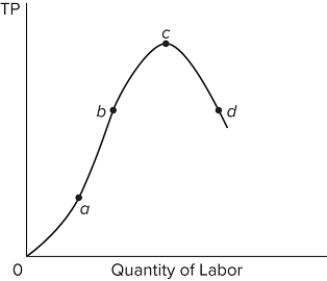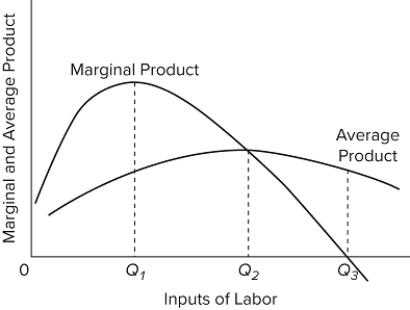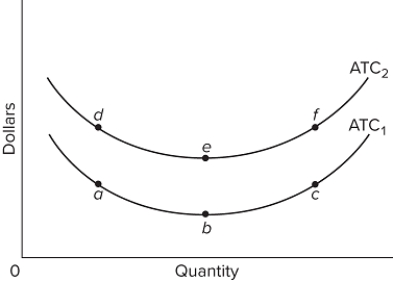A) sixth worker.
B) fourth worker.
C) third worker.
D) second worker.
Correct Answer

verified
Correct Answer
verified
Multiple Choice
Answer the question on the basis of the following cost data.  The average fixed cost of producing 3 units of output is
The average fixed cost of producing 3 units of output is
A) $14.
B) $24.
C) $16.
D) $8.
Correct Answer

verified
Correct Answer
verified
Multiple Choice
Chris is preparing for a comprehensive course exam by reading a textbook with chapters of equal length and difficulty. The number of chapters she can comprehend and master when studying is: (1) hour one, 1.5 chapters; (2) hour two, 2.0 chapters; (3) hour three, 1.5 chapters; (4) hour four, 1 chapter; (5) hour five, 0 chapters. Diminishing marginal returns to studying sets in for Chris after hour
A) one.
B) two.
C) four.
D) five.
Correct Answer

verified
Correct Answer
verified
Multiple Choice
Production costs to an economist
A) consist only of explicit costs.
B) reflect opportunity costs.
C) never reflect monetary outlays.
D) always reflect monetary outlays.
Correct Answer

verified
Correct Answer
verified
Multiple Choice
The following is cost information for the Creamy Crisp Donut Company.Entrepreneur's potential earnings as a salaried worker = $55,000Annual lease on building = $23,000Annual revenue from operations = $320,000Payments to workers = $130,000Utilities (electricity, water, disposal) costs = $8,000Value of entrepreneur's talent in the next best entrepreneurial activity = $80,000Entrepreneur's forgone interest on personal funds used to finance the business = $6,000Creamy Crisp's accounting profit is
A) $302,000.
B) $161,000.
C) $159,000.
D) $18,000.
Correct Answer

verified
Correct Answer
verified
Multiple Choice
Economies of scale are indicated by
A) the rising segment of the average variable cost curve.
B) the declining segment of the long-run average total cost curve.
C) the difference between total revenue and total cost.
D) a rising marginal cost curve.
Correct Answer

verified
Correct Answer
verified
Multiple Choice
The range over which average variable cost is increasing is the same as the range over which
A) marginal cost is decreasing.
B) average fixed cost is increasing.
C) average product is increasing.
D) average product is decreasing.
Correct Answer

verified
Correct Answer
verified
Multiple Choice
For most producing firms,
A) marginal cost rises as output is carried to a certain level, and then begins to decline.
B) total costs rise as output is carried to a certain level, and then begin to decline.
C) average total costs decline as output is carried to a certain level, and then begin to rise.
D) average total costs rise as output is carried to a certain level, and then begin to decline.
Correct Answer

verified
Correct Answer
verified
Multiple Choice
Fixed cost is
A) the cost of producing one more unit of capital, for example, machinery.
B) any cost that does not change when the firm changes its output.
C) average cost multiplied by the firm's output.
D) usually zero in the short run.
Correct Answer

verified
Correct Answer
verified
Multiple Choice
Other things equal, if the wage rates paid to a firm's labor inputs were to rise, we would expect the
A) AFC, AVC, ATC, and MC curves all to rise.
B) AVC, ATC, and MC curves all to rise.
C) AFC and ATC curves to fall.
D) MP curve to fall.
Correct Answer

verified
Correct Answer
verified
Multiple Choice
If the price of labor or some other variable resource decreased, the
A) AVC curve would shift upward.
B) AFC curve would shift downward.
C) AFC curve would shift upward.
D) MC curve would shift downward.
Correct Answer

verified
Correct Answer
verified
Multiple Choice
To the economist, total cost includes
A) explicit and implicit costs.
B) neither implicit nor explicit costs.
C) implicit, but not explicit, costs.
D) explicit, but not implicit, costs.
Correct Answer

verified
Correct Answer
verified
Multiple Choice
If the total cost of 20 units of a product is $20, and the total cost of 21 units is $21, then from 20 to 21 units of product the
A) marginal cost is decreasing.
B) marginal cost equals average total cost.
C) marginal cost equals average variable cost.
D) average total cost equals average variable cost.
Correct Answer

verified
Correct Answer
verified
Multiple Choice
Marginal product of labor refers to the
A) last unit of output produced by labor at the end of each period.
B) increase in output resulting from employing one more unit of labor.
C) total output divided by the number of labor employed.
D) smallest unit of the output produced by labor.
Correct Answer

verified
Correct Answer
verified
Multiple Choice
 Refer to the provided graph, which shows the total product (TP) curve. At which point is the marginal product zero?
Refer to the provided graph, which shows the total product (TP) curve. At which point is the marginal product zero?
A) point a
B) point b
C) point c
D) point d
Correct Answer

verified
Correct Answer
verified
Multiple Choice
 In the diagram, the range of diminishing marginal returns is
In the diagram, the range of diminishing marginal returns is
A) 0 Q₃.
B) 0 Q₂.
C) Q₁ Q₂.
D) Q₁ Q₃.
Correct Answer

verified
Correct Answer
verified
Multiple Choice
The law of diminishing returns indicates that
A) as extra units of a variable resource are added to a fixed resource, marginal product will decline beyond some point.
B) because of economies and diseconomies of scale, a competitive firm's long-run average total cost curve will be U-shaped.
C) the demand for goods produced by purely competitive industries is downsloping.
D) beyond some point, the extra utility derived from additional units of a product will yield the consumer smaller and smaller extra amounts of satisfaction.
Correct Answer

verified
Correct Answer
verified
Multiple Choice
 Refer to the graph. Which one of the following would cause a move from point b on short-run average total cost curve ATC ₁ to point e on short-run average cost curve ATC ₂?
Refer to the graph. Which one of the following would cause a move from point b on short-run average total cost curve ATC ₁ to point e on short-run average cost curve ATC ₂?
A) diminishing marginal returns
B) an increase in the wage rate
C) a decrease in the wage rate
D) increasing marginal returns
Correct Answer

verified
Correct Answer
verified
Multiple Choice
At an output level of 50 units per day, a firm has average total costs of $60 and average variable costs of $35. Its total fixed costs are
A) $925.
B) $1,250.
C) $1,750.
D) $3,000.
Correct Answer

verified
Correct Answer
verified
True/False
If the average product of labor equals 4 at all levels of output, the marginal product of labor is also equal to 4 at all levels of output.
Correct Answer

verified
Correct Answer
verified
Showing 401 - 420 of 445
Related Exams